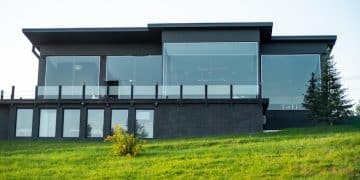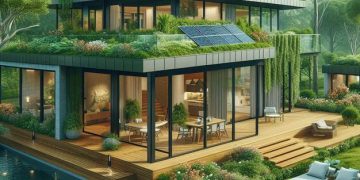Sustainable Home Construction: 3 Ways It Will Transform by 2026
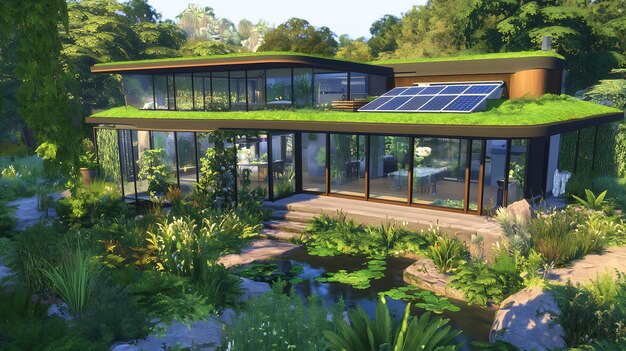
Sustainable building materials are poised to revolutionize home construction by 2026 through innovative eco-friendly options, reduced environmental impact and cost-effective energy efficiency, creating homes that are both environmentally responsible and economically sound.
The construction industry is on the cusp of a green revolution, and by 2026, 3 Ways Sustainable Building Materials Will Transform Home Construction by 2026, impacting not only the environment but also the way we live.
The Rise of Eco-Conscious Building Materials
The shift towards sustainability is no longer a trend but a necessity, with eco-conscious building materials leading the charge. This change marks a significant departure from traditional construction methods, prioritizing environmental responsibility.
What Defines a Sustainable Building Material?
Sustainable building materials are resources that have a minimal impact on the environment throughout their lifecycle. These materials are often renewable, recycled, or produced in a way that reduces energy consumption and pollution.
The Growing Demand for Green Homes
Homebuyers are increasingly seeking homes that align with their values, leading to a surge in demand for green homes. This demand is driving innovation and adoption of sustainable building materials in the construction industry.
- Reduced carbon footprint during manufacturing and transportation.
- Improved indoor air quality due to non-toxic material composition.
- Lower energy consumption through enhanced insulation and natural lighting.
- Conservation of natural resources by using recycled or renewable materials.
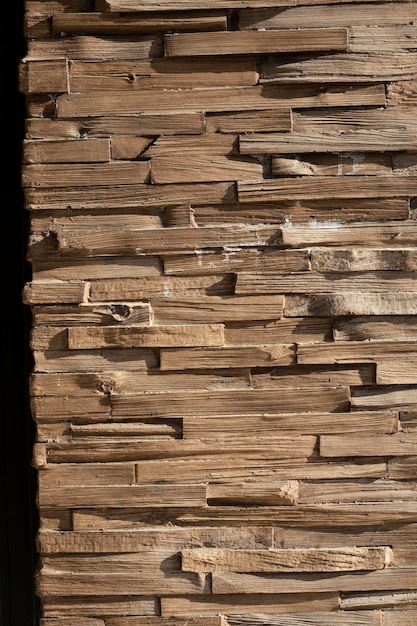
As awareness of environmental issues grows, the use of eco-conscious building materials is becoming increasingly prevalent. This trend is not just about building green homes, but also about creating healthier and more sustainable communities.
Cost Savings Through Energy Efficiency
One of the most compelling reasons for adopting sustainable building materials is the potential for long-term cost savings through enhanced energy efficiency. These materials contribute to reducing both energy consumption and utility bills.
Insulation and Thermal Performance Improvements
Sustainable materials often provide superior insulation compared to conventional options. This leads to better thermal performance, reducing the need for extensive heating and cooling systems.
The Impact on Utility Bills
Homes built with energy-efficient materials experience significantly lower utility bills. This not only saves homeowners money but also reduces the overall demand for energy resources.
Investing in sustainable materials can seem costly upfront, but the long-term savings on energy bills make it a worthwhile investment. Moreover, some governments offer incentives and rebates for homeowners who use sustainable building materials.
- Reduced reliance on traditional heating and cooling systems.
- Lower monthly utility bills due to decreased energy consumption.
- Increased home value as energy-efficient homes are highly sought after.
- Potential eligibility for tax credits and rebates from government programs.
Furthermore, energy-efficient homes contribute to a more sustainable future by reducing carbon emissions and promoting responsible energy consumption.
Innovative and Readily Available Sustainable Options
The availability of innovative and readily accessible sustainable building materials is rapidly expanding, making it easier for builders and homeowners to incorporate them into construction projects.
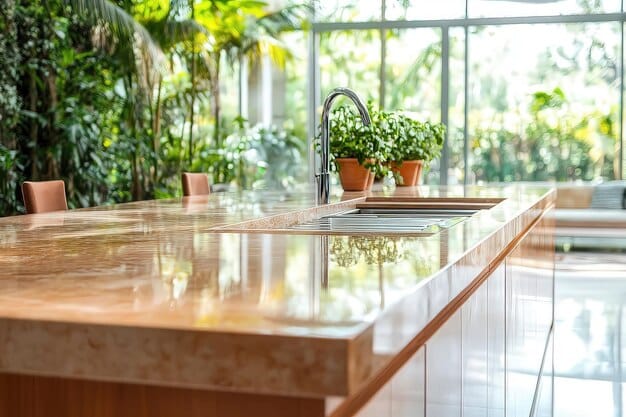
From Bamboo to Hempcrete: Exploring New Materials
Materials like bamboo, known for its rapid growth and strength, and hempcrete, a bio-composite made from hemp, are gaining popularity. These innovative alternatives offer unique benefits for sustainable construction.
Recycled and Repurposed Materials
The use of recycled and repurposed materials, such as reclaimed wood and recycled plastic, is becoming more common. These materials reduce waste and give new life to resources that would otherwise end up in landfills.
Advancements in technology are making sustainable building materials more accessible and affordable. As more builders and homeowners embrace these options, the construction industry is moving towards a greener future.
- Wider availability of sustainable materials in local building supply stores.
- Lower costs due to increased production and economies of scale.
- Greater ease of use with materials that are compatible with standard construction techniques.
- More design options as sustainable materials become more versatile and aesthetically pleasing.
With the increasing focus on sustainability, the construction industry is witnessing a revolution in materials, making it easier than ever to build environmentally friendly homes.
The Impact on Design and Aesthetics
Sustainable building materials are not just about functionality; they also offer unique design possibilities that can enhance the aesthetic appeal of homes. These materials can add character and visual interest to any construction project.
Natural and Organic Textures
Many sustainable materials, like wood and bamboo, have natural textures that add warmth and character to homes. These textures can be incorporated into both interior and exterior design elements.
Versatile Design Possibilities
Sustainable materials are versatile and can be used in a variety of design styles, from modern to rustic. This versatility allows homeowners to create unique and personalized living spaces.
Integrating sustainable materials into a home’s design can create a sense of harmony with nature, enhancing the overall living experience. These materials not only look good but also contribute to a healthier and more sustainable lifestyle.
- Unique color palettes and textures that enhance visual appeal.
- Design flexibility, allowing for a wide range of architectural styles.
- Improved natural lighting through strategic material placement.
- Enhanced connection with nature, bringing the outdoors in.
The use of sustainable materials in design is creating homes that are not only environmentally responsible but also beautiful and inspiring.
Overcoming Challenges and Looking Ahead
Despite the numerous benefits of sustainable building materials, there are still challenges to overcome in their widespread adoption. Addressing these challenges is crucial for the continued growth of sustainable construction.
Addressing Initial Costs and Perceptions
One of the main barriers is the perception that sustainable materials are more expensive than conventional options. While some materials may have higher upfront costs, the long-term savings often outweigh the initial investment.
Ensuring Quality and Durability
It’s important to ensure that sustainable materials meet the same standards of quality and durability as conventional materials. Proper certification and testing can help ensure that these materials perform as expected.
As awareness of the benefits of sustainable building materials grows, the industry is working to overcome these challenges. This includes developing new technologies, reducing costs, and educating consumers about the value of sustainable construction.
- Developing more cost-effective production methods for sustainable materials.
- Implementing stricter standards and certifications for quality control.
- Providing education and training to builders and homeowners on sustainable construction practices.
- Encouraging government policies and incentives to promote the use of sustainable materials.
By addressing these challenges, the construction industry can pave the way for a more sustainable and environmentally responsible future.
The Future of Home Construction: A Sustainable Vision
The future of home construction is undoubtedly sustainable, with green building practices becoming the norm rather than the exception. This shift will have a profound impact on the environment, economy, and the way we live.
The Trend Toward Net-Zero Homes
Net-zero homes, which produce as much energy as they consume, are becoming increasingly popular. These homes rely on sustainable materials and renewable energy sources to minimize their environmental impact.
The Role of Technology in Sustainable Construction
Technology is playing a key role in advancing sustainable construction practices. From smart home systems to advanced materials, technology is helping to make homes more energy-efficient and environmentally friendly.
The vision for the future of home construction is one of sustainability, innovation, and responsible resource management. By embracing sustainable building practices, we can create homes that are not only comfortable and beautiful but also contribute to a healthier planet.
- Increased use of renewable energy sources like solar and wind power.
- Development of smart home systems that optimize energy consumption.
- Adoption of green building certifications and standards.
- Collaboration between builders, architects, and homeowners to create sustainable communities.
Sustainable building materials are poised to transform home construction by 2026, leading to a more sustainable and prosperous future for all.
| Key Aspect | Brief Description |
|---|---|
| ♻️ Eco-Friendly Materials | Use of renewable and recycled resources. |
| 💰 Cost Savings | Lower energy bills and potential tax incentives. |
| 🏠 Design Versatility | Adaptable to various architectural styles. |
| 🌱 Health Benefits | Improved indoor air quality and healthier living. |
Frequently Asked Questions
Sustainable building materials are resources that have a minimal impact on the environment throughout their lifecycle. They are often renewable, recycled, or produced in a way that reduces energy consumption and pollution.
Sustainable materials often provide superior insulation compared to conventional options. This leads to better thermal performance, reducing the need for extensive heating and cooling systems and lowering utility bills.
Examples include bamboo, known for its rapid growth and strength, hempcrete, a bio-composite made from hemp, reclaimed wood, and recycled plastic. These materials reduce waste and offer unique benefits.
While some sustainable materials may have higher upfront costs, the long-term savings on energy bills often outweigh the initial investment. Additionally, government incentives and rebates may be available.
Sustainable materials offer unique design possibilities, adding character and visual interest to homes. They can enhance the aesthetic appeal with natural textures, versatile design options, and improved natural lighting.
Conclusion
As we look towards 2026, the transformation of home construction through sustainable building materials is not just a possibility, but a rapidly approaching reality. By embracing eco-conscious options, prioritizing energy efficiency, and exploring innovative materials, we can build homes that are both environmentally responsible and economically sound, paving the way for a more sustainable future.
